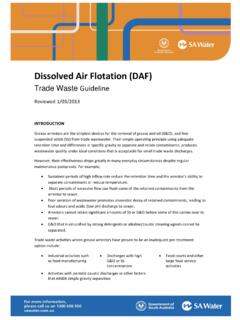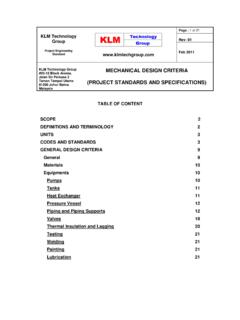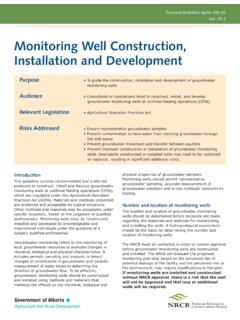Transcription of ALLOWABLE PIPE SIZE, CLASS AND MATERIALS FOR …
1 SOUTH AUSTRALIAN WATER CORPORATION TECHNICAL GUIDELINE Issued by: Manager Asset Management Issue Date: September 2011 TG 105 ALLOWABLE pipe size , CLASS AND MATERIALS FOR WATER MAINS PLANNING & INFRASTRUCTURE TG105 - pipe Sizes and MATERIALS for Water Mains Issued by: Manager Assets Planning September 2011 Uncontrolled on printing Page 2 of 13 SA WATER 2007 This document is copyright and all rights are reserved by SA Water. No part may be reproduced, copied or transmitted in any form or by any means without the express written permission of SA Water. The information contained in these Guidelines is strictly for the private use of the intended recipient in relation to works or projects of SA Water. These Guidelines have been prepared for SA Water s own internal use and SA Water makes no representation as to the quality, accuracy or suitability of the information for any other purpose.
2 It is the responsibility of the users of these Guidelines to ensure that the application of information is appropriate and that any designs based on these Guidelines are fit for SA Water s purposes and comply with all relevant Australian Standards, Acts and regulations. Users of these Guidelines accept sole responsibility for interpretation and use of the information contained in these Guidelines. SA Water and its officers accept no liability for any loss or damage caused by reliance on these Guidelines whether caused by error, omission, misdirection, misstatement, misinterpretation or negligence of SA Water. Users should independently verify the accuracy, fitness for purpose and application of information contained in these Guidelines. The currency of these Guidelines should be checked prior to use. MAJOR CHANGES INCORPORATED IN THE SEPTEMBER 2011 EDITION The following lists the major changes to the April 2007 edition of TG 105, which have been incorporated in this edition: 1.
3 First Edition. 2. Contact details amended September 2011. PLANNING & INFRASTRUCTURE TG105 - pipe Sizes and MATERIALS for Water Mains Issued by: Manager Assets Planning September 2011 Uncontrolled on printing Page 3 of 13 Contents SECTION 1: PURPOSE .. 2 SECTION 2: GENERAL .. 2 Additional Information .. 2 SECTION 3: BACKGROUND .. 2 ALLOWABLE pipe Sizes .. 2 ALLOWABLE pipe MATERIALS .. 3 ALLOWABLE pipe Pressure Rating (PN) .. 3 Minimum ALLOWABLE Mains Sizes .. 4 SECTION 4: RESPONSIBILITIES .. 5 SECTION 5: FURTHER INFORMATION .. 5 SECTION 6: REFERENCED DOCUMENTS .. 6 APPENDIX A ALLOWABLE pipe SIZES AND PRESSURE RATINGS .. A1 APPENDIX B PREFERRED size AND material FOR MAINS & METERS .. B1 Service Connections .. B2 APPENDIX C EQUIVALENT pipe SIZES .. C1 PLANNING & INFRASTRUCTURE TG105 - pipe Sizes and MATERIALS for Water Mains Issued by: Manager Assets Planning September 2011 Uncontrolled on printing Page 4 of 13 Section 1: Purpose To ensure that all water supply pipes installed in SA Water s infrastructure achieve the required economic life span, of 100 years, it is critical that the MATERIALS and characteristics of the pipe types be appropriate to that aim.
4 To achieve this, a consistent methodology for pipeline design criteria should be adopted to ensure the appropriate pipe is selected for each application. Section 2: General SA Water has for operational and maintenance purposes determined all acceptable pipe material types and their minimum ALLOWABLE Pressure Rating (PN). In addition, the range of ALLOWABLE pipe Diameters for pipes used in various water supply applications has also been specified. This document overrides all other instructions issued on the use of pipe MATERIALS installed in SA Water s water supply networks and is the prime document regarding the selection and use of pipe material within the networks. The document has been established by the Asset Management and Engineering staff and is based on Water Services Association of Australia (WSAA) pipe MATERIALS recommendations.
5 These will be revised on a two yearly basis and be signed off by the Manager Asset Management. Minor technical amendments may be added in the intervening period and these will be signed off by the Infrastructure Standards Manager ADDITIONAL INFORMATION All enquiries regarding this document shall be referred to the Infrastructure Standards Manager. Section 3: Background ALLOWABLE pipe SIZES SA Water have standardised on the following nominal pipe sizes for new installations, DN 63 (Polyethylene pipe only), DN 100, DN 150, DN 200, DN 250, DN 300, DN 375, DN 450, DN 500, DN 600, DN 750 as they are readily available in one or more pipe systems. Above this size pipe design should be based on hydraulic requirements and matching them to MSCL pipe manufacturer s standard production schedules. PLANNING & INFRASTRUCTURE TG105 - pipe Sizes and MATERIALS for Water Mains Issued by: Manager Assets Planning September 2011 Uncontrolled on printing Page 5 of 13 Polyethylene (PE) pipe (which is specified on the true outside diameter rather than a nominal inside diameter) has an equivalent size range as follows: Standard pipe size PE pipe Equivalent DN 100 125 mm OD DN150 180 mm OD DN200 250 mm OD DN250 315 mm OD DN300 400 mm OD PE pipe is also available in 25 mm, 32 mm, 40 mm, 50 mm and 63 mm some of which are currently being used for property service connections plus 90 mm, 110 mm, and 160 mm sizes which may be considered for country supply situations where a size for size replacement option is required.
6 (See Appendix B) ALLOWABLE pipe MATERIALS The following pipe MATERIALS have been assessed as acceptable for use within SA Water s water supply network: Ductile Iron Cement Lined (DICL) Polyvinylchloride Modified (PVC-M) Series 2 Polyvinylchloride Oriented (PVC-O) Series 2 Polyvinylchloride Unplastisised (PVC-U) Series 2 Polyethylene (PE) material types 80 (PE80) and 100 (PE100) Mild Steel Cement Lined (MSCL) (Sintacote external coating) Copper The preferred pipe material applications are as follows: Water Mains >DN100 PVC-M, PVC-O, DICL, PE and MSCL Water Mains <DN100 PE with Mechanical couplings Property Connections < DN100 PE with Mechanical couplings Full details of ALLOWABLE MATERIALS , pipe sizes and pressure ratings for specific applications are detailed in Appendix A. ALLOWABLE pipe PRESSURE RATING (PN) SA Water has for operational and maintenance purposes determined the minimum ALLOWABLE Pressure Rating (PN) and the corresponding range of ALLOWABLE pipe Diameters for pipes used in SA Water s water supply network.
7 The water industry typically require 100+ years from new mains. The type of material and pressure rating (PN) can have an effect on pipe life and while on the surface a lower CLASS pipe may appear to meet the hydraulic requirements there are other factors which need to be considered to ensure the desired asset life is achieved. The philosophy of using a CLASS of pipe at or just above the operating pressures is one which is not adopted by SAW and most other water agencies. The reasons for this are based on the manufacturer s estimated PLANNING & INFRASTRUCTURE TG105 - pipe Sizes and MATERIALS for Water Mains Issued by: Manager Assets Planning September 2011 Uncontrolled on printing Page 6 of 13 design life of the pipe and the methodology used to obtain this data. For example, the design life of all plastic pipes is based on the laboratory testing of pipe sections over extended periods of time to ensure the long term creep of the pipe will not cause the pipe to fail prematurely.
8 This laboratory testing is carried out in ideal conditions with pipe which is in its optimum condition. While a design factor or safety factor is applied during the design of the pipe wall dimensions, (design factor can vary from to depending on the type of plastic) it does not necessarily take into account all of the other aspects which can impact on a pipe during its service life. Some of these aspects can include, damage to pipe during installation, soil loads through poor compaction, the influence of tapping bands etc. As an example, SA Water installed PN6 PVC pipe as sewer rising mains, on the basis of the very low heads involved, about 15 years ago and these mains are now failing and have to be replaced as the design did not take into account the effects of fatigue. Laying of PN9 and lower CLASS pipes with their inherently thinner pipe wall requires additional care and supervision to prevent the pipe exceeding the ALLOWABLE pipe ovality limits.
9 Excessive ovality of the pipe creates the potential for pipe collapse as well as future maintenance problems when repairing/replacing sections of pipe . The cost of the extra work and testing involved in laying and compacting around the pipe would be equal to or greater than the savings made by purchasing lower CLASS pipe . CLASS PN 9 PVC pipe is generally not recommended for full vacuum situations especially where laying conditions may be less than optimal. Because of these issues, SA Water requires the use of PN 16 in general main laying For larger project based applications where the Maximum Operating Pressure is low (<600 kPa) and there is a fixed supply pressure, SA Water Technical staff may, at their discretion, authorise the use of a lesser CLASS of pipe . One additional benefit of using the higher pressure pipe is that in the future, where the pipe capacity is insufficient the supply can be increased by pump boosting.
10 This option can not be considered where the main is already operating at or near its recommended maximum ALLOWABLE operating pressure. Note:- PVC pipe manufacturers produce pipes in classes PN 6 and PN 9 primarily for the Irrigation Industry who only expect a pipe life of 25 years and purchase mainly on price. PVC pipes in this range are primarily manufactured as Series 1 (ISO size ) pipe which is commonly solvent welded and not permitted for SA Water s water main infrastructure. In the case of DICL pipe it is acknowledged that both PN 20 and PN 35 are manufactured. PN 20 is only manufactured in sizes DN225 and greater and has a thinner wall thickness than PN35 pipe . PN35 has however been specified for all DICL applications. This is not for pressure considerations but it is for long term resistance to corrosion due to the thicker wall of the pipe .










